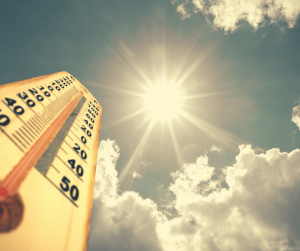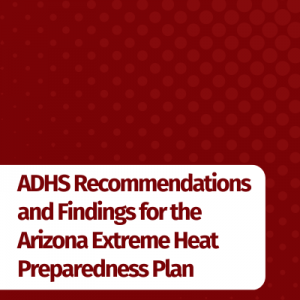 Heat-related illnesses in Arizona have been trending upward since 2013. Preliminary syndromic surveillance data suggest 2023 had the most heat-related emergency room visits in the last decade.
Heat-related illnesses in Arizona have been trending upward since 2013. Preliminary syndromic surveillance data suggest 2023 had the most heat-related emergency room visits in the last decade.
To better support Arizona through extreme heat as part of the Governor’s Executive Order on Extreme Heat Planning and Preparedness and Extreme Heat Preparedness Plan, the Arizona Department of Health Services is releasing our ADHS Recommendations and Findings for the Arizona Extreme Heat Preparedness Plan.
Arizona is experiencing increasingly longer periods of extreme heat, causing more Arizonans to experience heat-related illness, emergency room visits, and death. In order to address the challenges posed by rising temperatures, ADHS has developed the following recommendations to help protect our most vulnerable citizens and offer support for those who need it.
Some of the recommendations include:
- Unifying coordination of grassroots heat response activities with state agency efforts.
- Proposing impactful policy change to be accomplished through legislative actions.
- Investing in heat mitigation through grant and funding opportunities.
- Implementing a multi-modal communication plan promoting heat mitigation activities and resources.
- Developing multilingual and tailored education and outreach materials to reach vulnerable populations.
Taking proactive measures to mitigate the threats posed by rising temperatures is essential in protecting the health of Arizonans. These recommendations, which incorporate input from long-standing climate and health partners across the state, are an action plan to help reduce heat-related illnesses and deaths as well as prepare Arizona for extended periods of heat in future years.
ADHS has formed The Arizona Heat Preparedness Network, bringing together state and local partners, to carry out the implementation of the Governor’s Extreme Heat Preparedness Plan.
The department has also appointed Eugene Livar as its first statewide Chief Heat Officer and hired Taylor Lutich as its new Heat Relief Coordinator to help oversee the plan’s implementation, the department’s heat response, and to participate in the Arizona Heat Preparedness Network’s Steering Committee.
Key statistics that show the impact heat-related illness has had on Arizonans in 2022 and 2023:
- In 2022, there were 359 heat-caused deaths and 671 heat-related deaths in the state, an increase almost seven times greater than a decade earlier.
- 4,325 people visited hospitals or emergency rooms in 2022 due to illness caused by or related to heat-related illness.
- In 2023, there was an estimated 34.7% increase in heat-related illnesses based on preliminary data.
- While 2023’s heat data is still being reviewed for release later this year, preliminary data show a record number of heat-related emergency department visits.
- In 2023, Arizona experienced 73 days with temperatures greater than 100 degrees Fahrenheit and broke a record for most days in a row (31) that had temperatures higher than 110 degrees Fahrenheit.
 Anyone can be affected by heat-related illness. Vulnerable populations, including older adults, pregnant people, infants and young children, people who are unhoused, people in larger bodies, people who work outside, people who overexert during work or exercise, and people who are physically ill or on certain medications, are especially at risk of heat-related illness.
Anyone can be affected by heat-related illness. Vulnerable populations, including older adults, pregnant people, infants and young children, people who are unhoused, people in larger bodies, people who work outside, people who overexert during work or exercise, and people who are physically ill or on certain medications, are especially at risk of heat-related illness.
Living in Arizona for a long time does not make someone immune to the heat. From 2012 to 2022, the most heat-related and heat-caused fatalities occurred among people who have been in Arizona the longest. From 2012 to 2022, longtime Arizonans accounted for 933 heat-related deaths, or approximately 85 per year. For comparison: among people living in the state less than three years, there were approximately 19 such fatalities each year.
Temperatures are only projected to increase, potentially leading to more heat-related illness, emergency room visits, and loss of human life.
By 2030, Arizona is projected to experience up to 117 days over 100 degrees Fahrenheit. By 2060, nearly half the days in the year are projected to be over 100 degrees Fahrenheit, with some Arizona counties seeing warming up to 4.5 degrees Fahrenheit above current temperatures.
People living in Arizona’s rural areas are likely to experience the largest changes in temperature.
Our commitment to the safety and well-being of our communities is unwavering, and so we are taking proactive measures to mitigate the challenges posed by rising temperatures.
ADHS would like to give its thanks to Governor Hobbs for creating the foundation for this effort, its partners in the Arizona Heat Planning Summit who provided valuable insights included in ADHS’ recommendations, all county health departments participating in the heat response and to Jennifer Botsford and the ADHS Bureau of Environmental Health Services for spearheading ADHS’ heat planning. Botsford and her team have been instrumental in coordinating statewide efforts with our partners, planning last year’s heat summit, and have served as the lead on this project for our agency.
As we approach another very hot summer, take precautions to keep yourself and your family safe by following our social media accounts for updates throughout the season, sign up for excessive heat alerts, and visit our website for regular updates on the implementation of the plan and associated recommendations.










